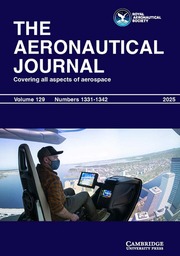Article contents
Unsteady aerodynamic effects of trailingedge controls on delta wings
Published online by Cambridge University Press: 04 July 2016
Abstract
Effective control of combat aircraft at high angles ofattack requires the flight control system to operateto higher frequencies and gains. This increases thepossibility of excitation of the structural modes byaltering the aeroservoelastic stability of thecomplete system. This paper details the results oftests carried out on a rigid, 55° leading edge sweepdelta wing, half model fitted with a half spanelevon operated through a closed loop controlsystem. The effects of steady elevon deflections upto 40° angle of attack are described. The unsteadypressures resulting from elevon oscillations atfrequency parameters up to a value equivalent to thefirst wing bending mode of a typical combat aircrafthave been measured. The effect of the elevonoscillation on the elevon itself and on the bendingmode have been estimated by calculating the unsteadyhinge and root bending moments about the wing root.The lower surface, unsteady elevon effects werefound to be independent of incidence and frequencyparameter. The amplitude of response of the weakvortex on the upper surface of the wing reducedrapidly with frequency parameter. Above an incidenceof 10°, the vortex breakdown was above the wing andled to a further reduction in the vortex response.The vortex response lagged the elevon motion.
Information
- Type
- Research Article
- Information
- Copyright
- Copyright © Royal Aeronautical Society 1995
Footnotes
Postgraduate researcher
Senior lecturer
References
- 2
- Cited by

